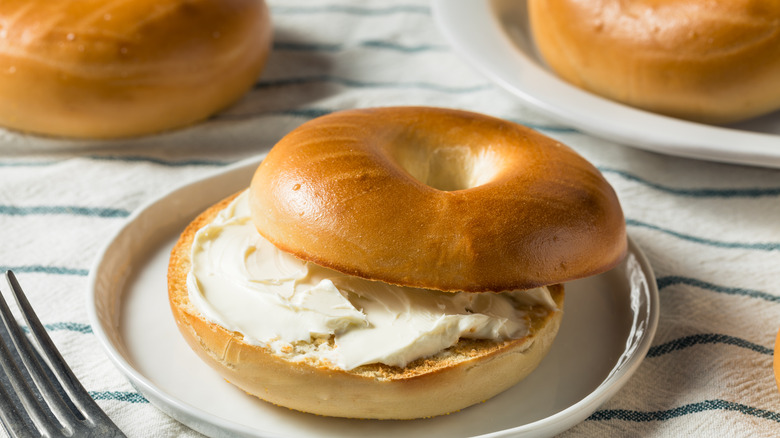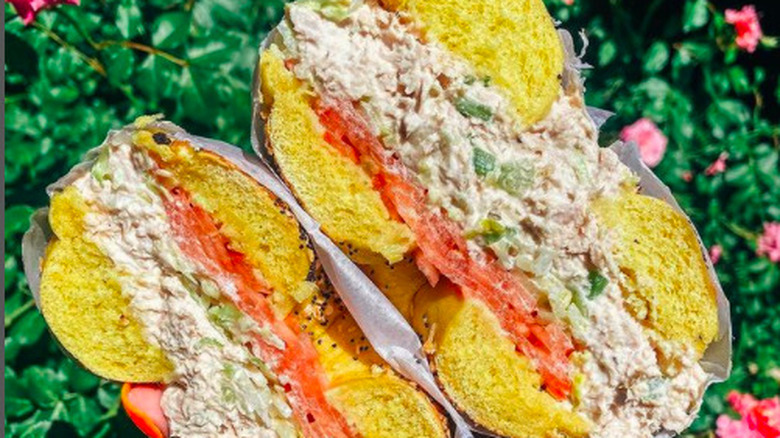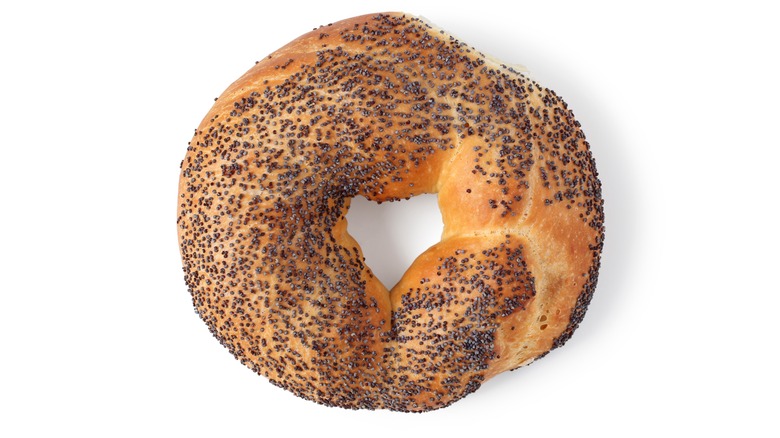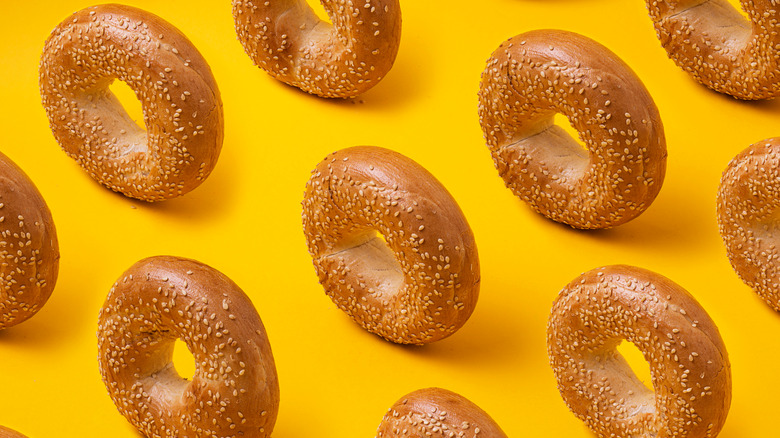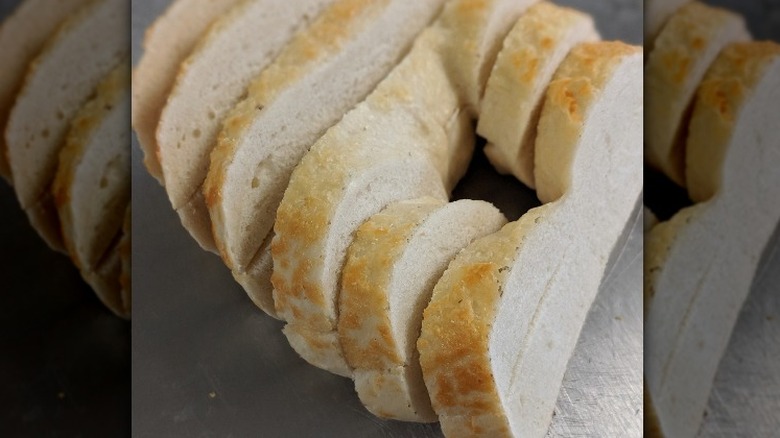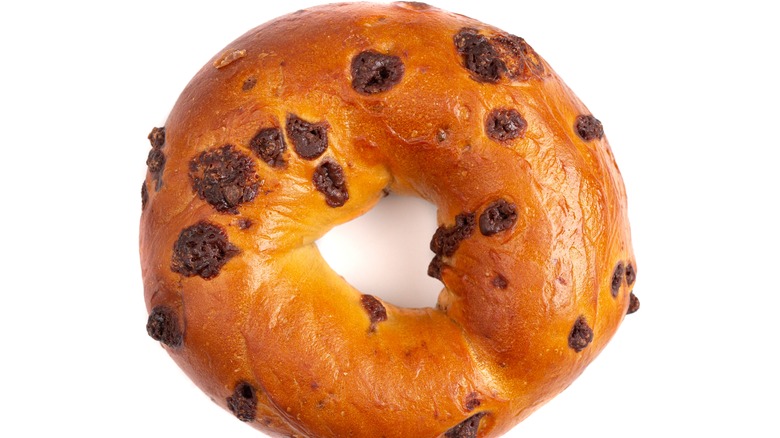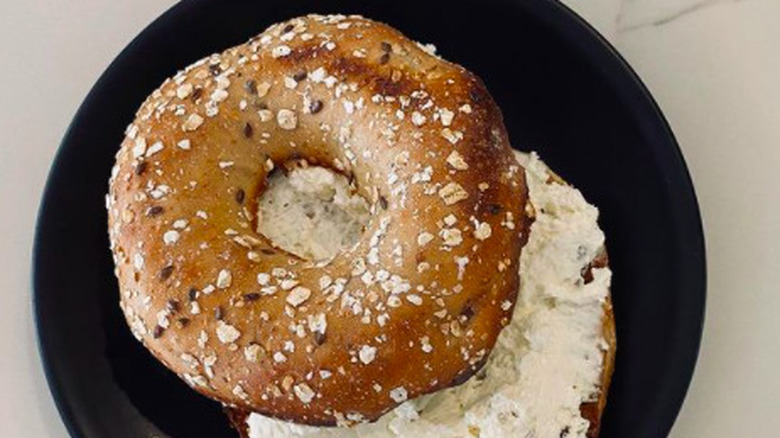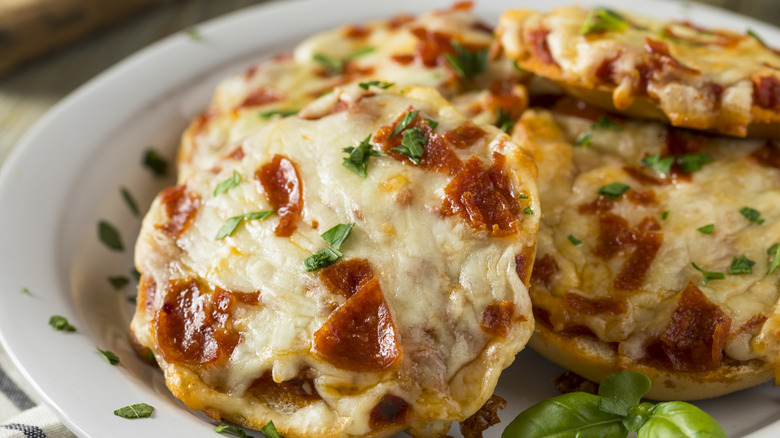28 Types Of Bagels, Explained
Bagels are the quintessential breakfast carb (sorry, English muffins). There are many untold truths about New York-style bagels, but the common history of the breakfast food can be traced back in time to 1300s Europe through its ancestor: the German pretzel. The bagel eventually went on to become a popular food for Jewish street vendors in Poland, where the bread was marketed toward the region's poor population. From there, the bagel moved to metropolitan New York City following swaths of European immigration in the late 1800s.
Unlike other types of bread, bagels are poached in water before baking. The poaching process gelatinizes the crust, resulting in a crispy exterior and soft, pliable interior. The poaching liquid for bagels typically contains a malt powder, which adds color and a touch of sweetness to the bagel after it's baked. There are many toppings and variations on the traditional bagel recipe — all of which are full of novel flavors and textures. Here are some of the most popular bagel variations found in stores and restaurants across the United States.
Plain bagels
As the name suggests, the plain bagel does not include any additional toppings besides an egg or starch-wash for color. Although these bagels get a lot of smack talk for being the most boring bagel in the bunch, the plain bagel is a versatile canvas for sweet and savory schmears. We recommend selecting a plain bagel for an Einstein Bros' breakfast sandwich made of bacon, egg, and queso.
A plain bagel's neutral texture is bound to soak up the onslaught of cheesy goodness inside this modern take on a breakfast sandwich. For the less adventurous eater, try topping your bagel with a fruity strawberry spread or the classic plain cream cheese.
Everything bagels
Everything bagels are our everything. These savory bagels are topped with a mixture of everything bagel seasoning, including garlic powder, onion powder, poppy seeds, sesame seeds, and sea salt. The everything bagel is the perfect snack for the indecisive folks out there because it contains toppings from some of the most common other bagel types. The everything bagel has furthered an obsession with everything seasoning on, well, almost everything — cantaloupe and everything bagel ice cream included.
You'll find everything bagels are the popular base for cream cheese and lox (cured salmon) breakfast sandwiches. The saltiness of the lox and the addition of fresh dill and capers elevate this bagel to its fullest potential, bringing out the aromatics and merging with salty flavorings.
Egg bagels
Eggs are common ingredients in enriched breads like challah, but this humble ingredient can actually elevate the flavor, texture, and color of a plain bagel. According to Gotham Bagels, bakers did not originally mix eggs into bagel dough because of the relatively high cost. After bagels immigrated to America, bakers started mixing eggs into the dough for a softer and puffier bagel.
From a scientific angle, the egg's fat helps weaken the gluten bonds in the dough slightly and acts as a leavening agent that puffs the bagel up and makes it much more tender than a standard plain bagel.
Sourdough bagels
Sourdough bagels have a much more distinct flavor than other bagels due to the use of a naturally-leavened culture of yeast and bacteria. Like a sourdough type of bread, bagels use a sourdough starter for most of the leavening; some bakers may add a bit of commercial yeast to boost the rise and speed up the leavening reaction (via the Bread Guide). Sourdough bagels take a significantly longer time to rise than conventional bagels because the wild yeast and bacteria culture need time to digest the carbohydrates in the surrounding flour and emit the carbon dioxide that gives the bagel its rise.
Sourdough bagels are topped with sweet or savory schmears and may include sprinkled toppings like everything seasoning, poppyseeds, or sesame seeds. The beauty of this bagel is what's inside, rather than the superficial dressings.
Blueberry bagels
Blueberry-flavored bagels are less-savory bagels with pockets of tangy, sweet blueberries baked inside. Proponents of the blueberry bagel flavor appreciate its chewy crust and fruity flair, while its opponents are appalled that anyone would ever consider putting fruit into a bagel. Unlike other varieties of bagels, the blueberry bagel is exclusively sweet-schmear-only, so bagel-goers may find themselves limited to what kinds of toppings can pair with the fruity concoction.
When it comes to a blueberry bagel, we recommend just choosing plain or low-fat cream cheese — it will let the fruity flavor of the bagel be the star. While you can always add butter for a salty addition, we recommend the traditional route.
Montreal bagels
Montreal bagels are a specific style of bagel with a wider hole than the New York bagel, which is a distant cousin. Along with this bigger gap, Montreals' feature the addition of a few flavor-enhancing ingredients: honey and eggs. These bagels are also shaped differently; bakers make long logs of dough before tying the ends together and rolling. The result is a thin, crunchy bagel with more exterior surface area.
After the bagels are boiled, the baker places the bagels into a wood-fired oven instead of a traditional New York bagel steam or convection oven. Montreal bagels are usually topped with savory breakfast toppings and flavored cream cheese — like salty lox and dill.
Cinnamon raisin bagels
According to the New York Times, there is no definitive proof of who created the first cinnamon raisin bagel. Still, it is likely that the popularizing of cinnamon toast by Pepperidge Farm and Wonder Bread led some bakeries to adapt a cinnamon raisin recipe to its bagels. But the history of this controversial bagel isn't important — the only important question is if you believe cinnamon raisin bagels should have the right to exist. The Wall Street Journal notes that some New Yorkers are adamant that the bagels should even be given the title of a "bagel."
Per The Atlantic, the cinnamon raisin bagel also made history yet again when Sex in the City star and Democratic gubernatorial candidate Cynthia Nixon revealed her bagel order from Zabar's in New York: a cinnamon raisin bagel with lox, red onion, capers, cream cheese, and dill. We'll let you decide who to vote for.
Asiago bagels
Asiago bagels are cheesy, carby, bites of goodness, according to King Arthur Baking Company. The asiago bagel gets its distinct cheesy flair from cheese both inside the bread and baked on top of the bagel. Some asiago bagels, like those from Einstein Bros', contain multiple kinds of cheese besides asiago, including parmesan and romano.
The asiago bagel is the perfect base for a breakfast sandwich. We recommend using it as the base for our bacon, egg, and cheese breakfast sandwich recipe. It features a unique bagel spread made from two unlikely yet commonly simple ingredients: butter and sriracha. You can cook your eggs in the spicy butter to add an additional layer of flavor, or melt the butter and spread it on your toasted bagel before adding the rest of your breakfast sandwich toppings.
Salt bagels
If you love pretzel salt, you're bound to love a salt bagel. Per Gotham Bagels, the salt bagel is a traditional offering in New York City delis where the salt on top of the bagel is in big crystals and imparts a — you guessed it — intense saline flavor onto the bread. In many European cultures, combining salt and bread is a symbol of greeting and blessings. And a salt bagel will definitely bless your tastebuds.
Use a salt bagel for any application as a plain bagel. Although some bagel snobs only eat salt bagels with savory spreads, you'll find that the salt can also elevate the flavors of a sweet cream cheese or jam. (Comparatively, you'll find that those sugary toppings bring a salt bagel's sky-high sodium flavorings back to Earth.)
Poppy seed bagels
Poppyseed bagels are somewhat inconspicuous. According to Spice Advice, the poppy seed originated in the Mediterranean region and dispersed with the movement of people toward Europe. Many German, Slavic, and Jewish recipes use poppy seeds for a slightly nutty flavor on bread or in muffins, cake, or other batters.
The poppyseed bagel is a nuanced bagel that pairs well with the sweet or the savory. However, there is one particular instance you should steer clear of these bagels: right before a drug test! According to information from Winchester Hospital, false positive test results frequently appear for individuals who consume poppyseed bagels before taking drug tests. Since different organizations have different thresholds for opium levels (the flower from which the poppy seed originates), there is no concrete answer for how many bagels you'd have to eat to fail a drug test. Instead, we recommend just having another bagel on this list.
Sesame bagels
Like poppy seed bagels, sesame bagels are kind of the "Plain Jane" of the bagel world. But according to an article published in the Pharmacognosy Review, sesame seeds have many powerful nutrition benefits that should set this bagel further towards the top of your list. The sesame seed is a source of polyunsaturated fatty acids, tocopherols, and vital vitamins and nutrients.
The sesame seed also has antioxidative properties that are beneficial for liver and heart health. Maybe this is why New Yorker Bagels recommends pairing a sesame bagel with a hefty dose of olive oil or a pat of butter spread. The salt from your shmear can really highly the toasted flavors of sesame, but you can also top with your favorite cream cheese or a fried egg.
French toast bagels
French toast bagels have risen in popularity with retailers like Panera Bread. Although it appears as though French toast bagels may be considered a fad that will pass in the coming years, the French toast bagel is actually one of the most flavorful types of bagels out there; you'll find delicious maple notes aside from cinnamon sugar. Typically, french toast bagels will have a cinnamon-sugar streusel on top as well as a sweet infusion in the dough.
Although your first thought might be to combine the French toast bagel with a sweet or neutral spread, we'd recommend making a continental breakfast sandwich that covers all the bases. Maple-glaze is having a Reinassance moment regarding bacon pairings, so a crisped French toast bagel with eggs, cheese, and sweetened bacon is a sign of the times.
Pumpernickel bagels
Pumpernickel is a type of flour made from the entire rye grain; the grain is usually made into sliced rye bread. Rye grain naturally has very low gluten content compared to other types of flour, so bakers using rye for a pumpernickel bagel must be sure to accurately account for a long rise time. True pumpernickel has a very dark and strong-flavor while most modern American and European "pumpernickel" is actually just light rye with coloring added. The coloring in this faux pumpernickel is typically coffee, cocoa, or molasses — all of which do not impart a strong flavor to the finished bread.
For a dark pumpernickel bagel (or bread), we recommend coating the bagel in butter, honey, and jam to contrast the dark, murky rye flavor. The mineral, slightly grassy notes will be uplifted by the saccharine play of the honey, while a salty touch of dairy or dairy-alternative spread will add another complex layer.
Whole wheat bagels
According to SF Gate, whole wheat bagels and whole grain bagels are not synonymous. Many bagels marketed as "whole wheat" are usually made with white flour along with the bran of the grain, while whole grain bagels contain the endosperm, the bran, and the germ. The bran in a whole wheat bagel provides more fiber than a standard white bagel, but not as much as a whole grain bagel.
A whole wheat bagel tastes a little more true and nutty than a plain bagel, so it is a popular choice for folks seeking a more fibrous breakfast option. Pair a whole wheat bagel with a drizzle of honey for sweetness or plain cream cheese.
Cheddar bagels
Cheddar bagels are fairly straightforward, and yet sometimes, they're accompanied by a spicy little companion: the jalapeno. These bagels hit with a slight bit of spice and warmth from a toaster — it's quite a transformational bagel experience. Like the asiago bagel, the cheddar bagel includes cheese baked in as well as on-top of the bagel.
The cheddar bagel is best when used for a breakfast sandwich that includes a cooling element, like avocado, along with a fatty element, like an egg or even more cheese. If you're feeling spicy, you can substitute a cheddar bagel for a hamburger bun for your Sunday night grilling session.
Sprouted bagels
Sprouted flours are not a different type of grain, rather, they are a grain harvested at a peak nutritional period. These grains have significantly more bioavailable nutrients than non-sprouted grains, as well as a plethora of vitamins A, B, and C, along with increased protein and magnesium (via Harvard School of Public Health). You can purchase sprouted bagel brands like Alvarado Street Bakery or Silver Hills at Whole Foods Market, Target, or other online retailers.
Sprouted bagels taste similar to whole grain bagels, and you'll find the same hearty texture and nutty undertones. Pair sprouted grain bagel with your favorite avocado mash, a squishy burrata ball, or your favorite hot sauce. Like other bagels on our list, there's no wrong way to eat a sprouted bagel!
New York bagels
New York bagels are one of the metropolitan's delicacies. The ideal New York bagel is above all chewy — with a pliable, tooth-sinkable exterior and elasticky interior. According to National Public Radio (NPR), New York bagels were originally thought to be different than other regions because of the low levels of calcium and magnesium in the water the bagels are boiled in. However, this theory has been disproven.
In fact, New York bagels are so uniquely chewy because the bagels are actually boiled, rather than just being cooked in the automated steam oven in commercial settings. This is why bagged bagels at the grocery store just don't taste the same as the ones from the corner deli in Brooklyn.
St. Louis style bagels
The Riverfront Times said it best: "St. Louis' charade as a city on the rise has been exposed as a fraud by the revelation that Saint Louis Bread Company slices its bagels like bread loaves, in defiance of God's will and all that is decent." According to Mashable, a 2019 tweet with a photo of these bagels spread like wildfire on the internet, infuriating bagel aficionados and New Yorkers alike.
Some, like Serious Eats, claim that cutting a bagel vertically into slices has more practical use than a single horizontal slice: sandwiching, hasselbacking, and croque monsieur-ing. Is this method an abomination? That's up to you to decide.
Chocolate chip bagels
If you didn't already have enough tooth-numbingly sweet options, enter the chocolate chip bagel. Opponents of the bagel will claim that it is too sweet to be considered a breakfast food, while its proponents will argue that the sweetness of the bagel is subdued with a fatty, nuanced spread like plain cream cheese (or even salt!). While this bagel is certainly not as versatile as other options listed, it does remain relatively popular among children and teen bagel consumers.
Home bakers can slightly alter the bagel's sweetness by using a mix of bittersweet and semi-sweet chocolate in the bagel dough. For the chocolate lovers among us, we recommend a thick schmear of Nutella or peanut butter to complement the other chocolate in this carby delight. Besides, is there anything such as "too much chocolate?"
Garlic bagels
Garlic bagels are a science that everyone seems to have a different idea of how to perfect. According to the Culinary Chronicles, you should add garlic powder to the bagel itself to impart a strong garlicky flavor. Adding garlic too prematurely can stunt yeast growth, though, so it is best to add the garlic after the bagel dough comes together, per The Practical Kitchen. Meanwhile, adding a fresh garlic and olive oil mixture after the bagels are almost fully cooked will prevent the garlic from burning and sliding off the bagel prematurely.
You can top garlic bagels with a range of savory and crunchy toppings. Try filling lettuce in your breakfast sandwich for an added layer of crispness. If you're looking for a great flavor contrast to the garlic, we suggest spreading a thin layer of hummus on your bagel, adding a nutty and creamy mix that diversifies the flavor.
Rainbow bagels
Rainbow bagels are guaranteed to be one of the most youthful baked goods around. These fun bagels were popularized by The Bagel Store in 2015 when owner Scot Rosillio released the colorful creations to the Brooklyn public, per Gothamist. Hundreds of patrons flocked to the store and caused a temporary shutdown of the shop shortly afterward.
The rainbow bagel is created through twirling strings of multicolored bagel dough into one cohesive bagel. While some shops' rainbow bagels do not taste different than others, The Bagel Store's patrons note that the bagel tastes slightly sweet with a vanilla undertone. Sometimes the joy of a rainbow bagel is in the color; other times, it's in the subtle sugary finish.
Gluten-free bagels
Even if you are gluten-intolerant, you still have to find a way to participate in the carb party! According to gluten-free health coach Rachael Roehmholdt, gluten-free bagels typically contain a combination of brown rice, sorghum, and buckwheat flour with either potato starch or tapioca starch. You can purchase a variety of gluten-free bagels from your grocery store, including brands like Against the Grain, O'Dough's, and Udi's. You can find some brands outside the gluten-free section with other frozen gluten-free baked goods.
Gluten-free bagels are slightly more dense than gluten bagels but come in some of the same flavors as gluten-based varieties. Toast and schmear gluten-free bagels as you would regular bagels. When it comes to preparing these bagels, the best-recommended method is to go low and slow. Too high of a temperature can burn the outside while leaving the inside of your bagels woefully undercooked.
Onion bagels
Like the garlic bagel, onion bagels are typically both flavored with onion powder and topped with onions. This seasoning delivers a somewhat strong and surely acquired taste.
Onion bagels are reserved for savory toppings only, so these bagels are much less versatile than other varieties. For example, an easy pairing would be combining an onion bagel with thick-cut bacon, avocado, and eggs for a classic breakfast sandwich packed with pungent notes. Add caramelized onions to your breakfast sandwich for a stronger flavor and novel texture. The tips you need for caramelized onions on a sandwich include keeping an eye on the clock; It is important to give the onions (or any food, really) time to caramelize — and this process can take up to 45 minutes. So sit back, get a pot of coffee going, and plan accordingly.
Multigrain bagels
You're likely to find multi-grain bagels at your local Dunkin' franchise. The company makes its multi-grain bagels with sunflower seeds, flax seeds, millet, oats, wheat bran, barley, and sesame seeds. The multi-grain bagel has twice the amount of fiber as the Dunkin' plain bagel, so it is a better option for customers seeking a filling breakfast on the go.
If you're looking for multi-grain bagels at home, we recommend trying Dave's Killer Bread Epic Everything Bagels. These delicious bagels are a hybrid between an everything bagel and a multi-grain bagel. You'll find the inside of this bagel brimming with sunflower seeds, flax, and chia, along with a delicious dose of garlic, onion, and poppy seeds on the exterior.
Bagel bombs
Bagel bombs are hand-held bagels stuffed with a pocket of cream cheese. Most bagel makers will freeze balls of cream cheese ahead of time to make the bagel formation process easier, per King Arthur Baking Company. After the dough has completed its rise, the balls of cream cheese are enclosed in sheets of dough before poaching. The baker must be sure to wrap the entirety of the cream cheese and seal the dough to prevent spillage. Then, the bagels are coated in an egg or starch wash before baking.
Bagel bombs can be topped with any topping as traditional bagels, including poppy seeds, everything, and sesame. You can also experiment with cream cheese flavors to see which fits the best with the topping. Good for eating on the move, for a quick snack, or efficiently feeding a larger group of people, bagel bombs will help you win the fight against early morning hunger.
Bagel twists
Bagel twists are a concoction also popularized by the Dunkin' franchise, but this bake and boiled good has now made its way into home kitchens and bakeries alike. Although the bagel twist may appear difficult to make by hand, it is merely bagel dough twisted and topped with your choice of ingredients; cheddar cheese is one of the more popular bagel twist toppings, as the cheese helps bring everything together.
To form bagel twists, The Old Woman and the Sea recommends rolling out individual logs of dough. Pinch two of the logs together at the top and twist until intertwined. This forms the twisted shape and can be braided or include more than two dough logs for a more complex shape.
Mini bagels
Mini-bagels are super simple to make because it's just normal bagel dough — but smaller! Mini-bagels are particularly useful for recipes like homemade pizza bagels. To prevent cheese, sauce, and toppings from falling through the inside of the bagel hole, try covering the hole with a piece of pepperoni.
You can also experiment with different cheeses and toppings for the perfect pizza bagel; try substituting a homemade pesto for tomato sauce to develop a more herbaceous flavor. If you plan on adding seasonings or leafy greens, position the leaves underneath the cheese to prevent burning while the pizza is broiling in your home oven.
Bialy
A bialy resembles the same shape and flavors as a bagel. According to Food Republic, bialys, unlike bagels, are baked instead of boiled and baked. Because the bialy is not poached, it does not have the same shine or chew as a bagel. The inside of the bialy is puffy and bubbly, but these breads won't give you the same "pull" as a classic bagel.
At first glance, you can tell the difference between a bagel and a bialy by the hole in the center (or lack thereof). Bialys are formed with a depression in the center, rather than a hole, per What's Cooking America. Bakers can fill this indentationed with poppy seeds, garlic, or onion. Bialys can be schmeared with cream cheese just like its bagel cousins or just eaten straight from the oven without any additional spread. Though texturally different, the flavor of a bialy will be roughly similar to a plain bagel and will depend most heavily on the quality of wheat used.

